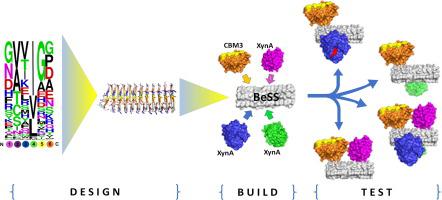Computational and Structural Biotechnology Journal ( IF 6 ) Pub Date : 2021-01-16 , DOI: 10.1016/j.csbj.2021.01.011 Matheus P. Pinheiro , Renata A.G. Reis , Paul Dupree , Richard J. Ward

|
Effective use of plant biomass as an abundant and renewable feedstock for biofuel production and biorefinery requires efficient enzymatic mobilization of cell wall polymers. Knowledge of plant cell wall composition and architecture has been exploited to develop novel multifunctional enzymes with improved activity against lignocellulose, where a left-handed β–3-prism synthetic scaffold (BeSS) was designed for insertion of multiple protein domains at the prism vertices. This allowed construction of a series of chimeras fusing variable numbers of a GH11 β-endo-1,4-xylanase and the CipA-CBM3 with defined distances and constrained relative orientations between catalytic domains. The cellulose binding and endoxylanase activities of all chimeras were maintained. Activity against lignocellulose substrates revealed a rapid 1.6- to 3-fold increase in total reducing saccharide release and increased levels of all major oligosaccharides as measured by polysaccharide analysis using carbohydrate gel electrophoresis (PACE). A construct with CBM3 and GH11 domains inserted in the same prism vertex showed highest activity, demonstrating interdomain geometry rather than number of catalytic sites is important for optimized chimera design. These results confirm that the BeSS concept is robust and can be successfully applied to the construction of multifunctional chimeras, which expands the possibilities for knowledge-based protein design.
中文翻译:

使用串联重复左旋β-3-棱镜支架增强木聚糖酶活性的CBM3-GH11嵌合体的植物细胞壁结构指导设计
有效利用植物生物质作为生物燃料生产和生物精炼的丰富和可再生原料,需要细胞壁聚合物的有效酶促动员。已利用植物细胞壁组成和结构的知识来开发具有改善的针对木质纤维素活性的新型多功能酶,其中设计了左旋β–3棱镜合成支架(BeSS),用于在棱柱形顶点处插入多个蛋白质结构域。这允许构建一系列嵌合体,其融合具有可变距离的GH11β-内切-1,4-木聚糖酶和CipA-CBM3,并具有限定的距离和受约束的催化域之间的相对取向。维持所有嵌合体的纤维素结合和内切木聚糖酶活性。对木质纤维素底物的活性显示为快速1。通过使用糖凝胶电泳(PACE)进行的多糖分析测得,总还原糖释放量增加了6至3倍,所有主要寡糖的含量增加。在同一棱柱顶点上插入CBM3和GH11域的构建体显示出最高的活性,这表明域间的几何形状而不是催化位点的数量对于优化嵌合体设计很重要。这些结果证实,BeSS概念是可靠的,可以成功地应用于多功能嵌合体的构建,从而扩展了基于知识的蛋白质设计的可能性。在同一棱柱顶点上插入CBM3和GH11域的构建体显示出最高的活性,这表明域间的几何形状而不是催化位点的数量对于优化嵌合体设计很重要。这些结果证实,BeSS概念是可靠的,可以成功地应用于多功能嵌合体的构建,从而扩展了基于知识的蛋白质设计的可能性。在同一棱柱顶点上插入CBM3和GH11域的构建体显示出最高的活性,这表明域间的几何形状而不是催化位点的数量对于优化嵌合体设计很重要。这些结果证实,BeSS概念是可靠的,可以成功地应用于多功能嵌合体的构建,从而扩展了基于知识的蛋白质设计的可能性。



























 京公网安备 11010802027423号
京公网安备 11010802027423号